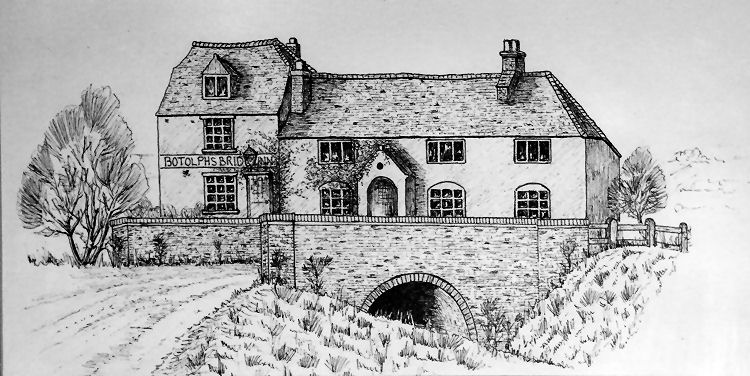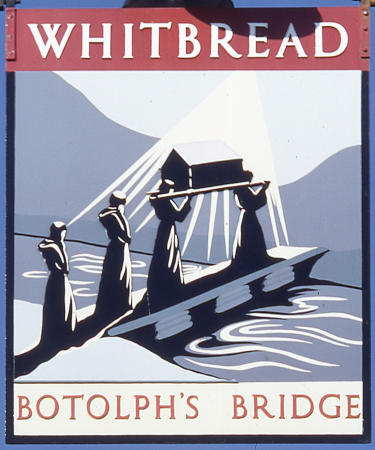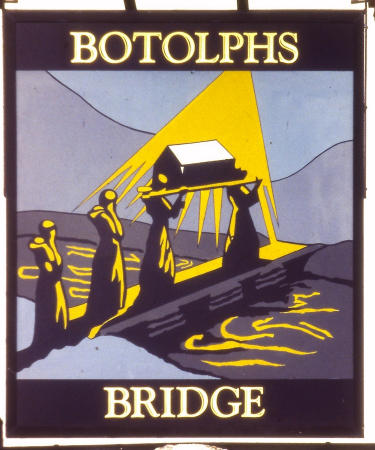|
Botolphs Bridge Road
West Hythe
01303 267346
http://www.botolphsbridgeinn.co.uk
https://whatpub.com/botolphs-bridge-inn

Above line print, 1908. |

Above line print 2008. |

Above photo, 1935. Kindly sent by Rory Kehoe. |

Above painting, date unknown. |

Above print taken from "Old Country Inns of England." |
 Above photo showing taken 2010 from their web site. |
 Above photo showing taken 2010 from their web site. |
 Above photo showing the bar in 2004. |
  Above sign
left 1974, sign right 1996.
With thanks from Roger Pester
www.innsignsociety.com.
|

Above sign 2010
 
Botolphs Bridge sign left 1970s, sign right March 1991.
Above with thanks from Brian Curtis
www.innsignsociety.com |

Above aluminium card issued June 1951. Sign series 3 number 9. |

Above photo showing the "Botolph's Bridge" dart team of 1947. |
Kelly's Directory of 1903 addressed this as Burmarsh.
|
THE LEGEND OF BOTOLPHS BRIDGE
(As related by Duncan Forbes in his book "Hythe Haven" pub 1981)
The English monk St. Botolph lived in the seventh century, and many
popular tales have been told about him, since there is very little known
historical fact. His monastery is thought to have been in Boston,
Lincolnshire, which has derived its name from "Botolph's Town". But our
legend about the saint concerns his dead body and Botolph's Bridge.
Go to the bridge across the Canal Cut at West Hythe, which is not the
same as the original bridge before the canal was constructed, and look
at the Inn sign there, which illustrates the story. Two more monks are
following them from the bank, and a shaft of light is seen shining down
on all of them out of a dark sky.
The legend is that the body of St. Botolph was lying borne to some
place where it would be kept safe from desecration by the heathen Danes.
There was water to cross, and the night was pitch black. Then suddenly a
shaft of light, which was not the moon, shone down from heaven to guide
the escort as they went aboard. But where the body now lies, no one
knows.
The bridge by the Inn spans a stretch of water that is now a branch
of the Royal Military Canal, draining into the sea through the sluice
beside the Grand Redoubt built during Napoleonic Wars. But in the past
it carried travellers to the shore across one of the many creeks of the
marsh. It was called Boter's, Butter's or Butler bridge on the old maps,
whether Butler is derived from Botolph, or whether there really is a man
in charge of the drinks there, a there is today, or whether, as is more
likely the name came from that of a well-known local family. I do not
know.
What I do know is that, with the sheep meadow around you, the placid
water nearby, the Roman ruins, looking like old, decaying teeth
sprouting out the hillside, and the more modern castle with its Second
World War reinforced concrete watchtower on the skyline, there is no
pleasanter place to stop and take a glass.
|
|
From the Canterbury Journal, Kentish Times and Farmers' Gazette, 7 January 1905.
WEST HYTHE. WEDDING BELLS.
A very pretty wedding took place on Boxing Day at St. Stephen's parish
church, Lympne, the contracting parties being Mr. MacDonald Taylor, only
son of Mr. D. Taylor, of Wayfield House, West Hythe, and Miss Edith Jane
Sellen second daughter of the late Mr. John Sellen, of "St. Botolph's
Inn" West Hythe, and Mrs J. Sellen, of Jordan's Temperance Hotel,
Faversham.
The ceremony was performed by the Rev. H. B. Biron, Vicar of Lympne.
The bride looked charming in a dress of silver grey trimmed with white
silk, and wore a grey Ligton hat trimmed with white and sprays of orange
blossoms. The bridesmaids were Miss H. Wratton and Miss Totty Taylor,
sister of the bridegroom. They wore navy costumes with white silk
blouses, and hats of navy Ligton trimmed with white silk and sprays of
ivy. They also carried sprays of ivy and white chrysanthemums, the gift
of the bridegroom. The bride was given away by Mr. Henry Heywood
Piddock, of brockman's Barn, and Mr. T. Wratten acted as best man.
During the evening a merry peal was rung on the church bells. A
reception was held at "Botolphs bridge Inn," when about 40 sat down to
an excellent spread. Amongst the gusts present were Mrs. Sellen, mother
of the bride; Miss A. Taylor and Miss T. Taylor, sisters of the
bridegroom; mr. and Miss Pilcher, of Ashford; Mr. and Mrs. C. Piddock,
of Burmarsh; the Misses H., and L., and A. Wratten, Mr. H. Piddock, Mr.
T. Wratten. Mr. A. Wratten, Miss Trear, and Miss Keeler. The bride
received a large number of useful presents.
|
|
Folkestone, Hythe, Sandgate & Cheriton Herald, Saturday 20 June 1914.
Saturday's storm. Houses struck by lightning. Animals killed.
Early on Saturday morning a remarkable thunderstorm passed over Hythe.
At the Dentals, the residence of Mrs. J. F. Shelford, in North Road, the
lightning struck a chimney stack at the west side of the house, making a
big hole in the stack itself and tearing up a large number of tiles on
the roof surrounding it. An immense crack was created extending down the
stack the stack into the servants' room below, where, luckily, no
further damage was done, except that the paper was scorched. The
occupants of the room were naturally match alarmed for the time being.
It was at about one in the morning when the thunderstorm become
noticeable, and from 1:15 to 1:35 it was at its height. Flash succeeded
flash, and roll followed role in quick succession. The lightening was
extraordinary vivid. Nothing like it has been known in the town for very
many years. The rain came down in torrents, and from the appearance of
the streets in the morning it was easy to see that the rushing water had
difficulty in getting away in several places. There were signs of a
great rush of water down Tanners Hill, while in Mill Road, close by,
parts of the thoroughfare were covered in mud washed there. There were
other roads in a similar state and in Stade Street the sudden flood
entered the "Hope Inn," where the landlord was put to considerable
trouble in clearing out the mud, etc, brought in by the water.
In one or two parts of the town, too, the electric cable seemed to have
been affected by the storm, and people could not light their rooms when
desired. However, this received quick attention from the Electricity
Company and by the afternoon, the cables were in working order. Some of
the goods, also, in the shops of electricians were affected in various
ways.
West Hythe the most serious damage in the neighbourhood occurred. "Botolph's
Bridge Inn," occupied by Mr. George Piddock, suffered severely and some
of the tenants had a marvellous escape. The lightening seems first of
all to have caught the chimney stack, which it knocked down into the
roof of the top room, making a big hole. The occupant of this room, was,
needless to say, very much frightened, but in the bedroom below a worse
experience befell two people who were in bed. A window was completely
smashed and taken partly out of the wall, carrying away some bricks and
mortar; the lightning then appears to have caught the brass knob at the
foot of the bed and passed down underneath the bed itself to the bottom
of the wall at the head, where it vented itself on the bricks and mortar
and passed away through the hole made. When Mr. Piddick got a light he
found the room full of smoke, and he had to open the door to clear it.
However there was no fire about. The lighting also "touched" other parts
of the inn in minor ways.
Mr. J. T. Clarke, of Botolph's Bridge Farm, lost two horses; one was
killed by lightning, while the other evidently ran into a pond i its
fright and was drowned. Mr. P. J. Uden, of the "Carpenter's Arms," lost
a sheep and three lambs, and one or two other farmers around West Hythe
also suffered in this way.
At Pedlinge a large tree was stripped of its bark by lightning.
|
|
Folkestone, Hythe, Sandgate & Cheriton Herald, Saturday 6 January 1923.
BURMARSH SMOKING CONCERT.
On Tuesday evening a smoking concert was held at "Botolph's Bridge Inn."
A capital programme was carried out by Messrs. Neve, Parry, Rolph, Tutt,
and Mutton, with Mr. Mowatt at the piano. A collection for the Royal
Victoria Hospital, Folkestone amounted to £1 3s.
|
|
From the Folkestone, Hythe, Sandgate & Cheriton Herald, Saturday 28 May, 1932.
MARRIAGE. PARRETT – MACSHARRY.
At the Royal Catholic Church, Guildhall Street, Folkestone, on April
30th, Mr. Maurice R. S. Parrett, son of Mr. and Mrs. Parrett, “Botolph’s
Bridge Inn,” Hythe, to Miss Kathleen W. Macsharry, 16, Manor Road,
Folkestone.
|
|
From an email receive 8 September, 2014. I browsed your entry of the
pub, to see what information you had about ownership during & post WW2.
You could show a much more interesting history of this lovely pub, if
you availed yourself of a copy of the book, "The Flying Sword" (a
history of 601 Squadron)
This famous RAF Squadron used the pub whilst attending summer camps
at Lympne. The road sign for Dymchurch from the nearby junction became a
'mess trophy' after a landing accident.
I am interested in what happened to the propeller displayed in the
bar in the 1970s and any other stories you may unearth.
Excerpt from, "The Flying Sword" by Tom Moulson (a history of 601
Squadron Royal Aux AF (the Millionaires Squadron).
During summer camps at Lympne private aircraft were flown off the
aerodrome and put down alongside the favourite pub, Botolph's Bridge
Inn, a picturesque tavern among the sheep pastures of Romney Marsh.
Although some of these aerial run-abouts were dazzlingly impressive,
others were held together by a few strips of sticking plaster and the
ingenuity of the squadron's mechanics. The Legion*
was so closely knit that a mechanic would never object to working on his
officer's aeroplane even though he knew that after dinner it might be
used, as though it were a bicycle, to fly a mile or so down the road for
a game of darts.
On an evening in 1935 the Legionnaires were assembling at Botolph's
Bridge before the rabbit hunt. When it became dark, live rabbits would
be caught in the headlamps of a motor car, then put through every window
found open on the airfield precincts. Once almost two hundred had been
caught and all let loose in the bar of the Cinque Ports Flying Club, the
barman who found them next morning had to be coaxed out of taking a
week's sick leave.
The evening was warm and the door of the inn was left open. Through
it drifted the strains of a concertina, played by Peter Robinson as he
leaned against the bridge and the sounds of aero engines, as the little
machines rose just beyond the brow of the hills, cruised the two miles
then circled over the inn and followed each other into the stamp sized
field opposite.
Roger Bushell in (Max) Aitken's Aeronca, eager and thirsty, made a
crisp approach over the taxying machines, swerved to avoid a sheep and
touched down too late. As his plane tore through the hedge and
disintegrated on the highway, less than 20yds from the inn, it
decapitated a signpost which read, “To Dymchurch”. Bushell stepped
unscathed from the wreckage, apologized to Aitken and began to auction
off the Aeronca's remains. The “TO DYMCHURCH” sign became one of the
Squadron's most treasured mementos, locked up with the Squadron silver
and displayed on mess nights.
*Squadron Leader Roger Bushell was one of the
‘great escapers' from Stalag Luft III at Sagan and was murdered by the
Gestapo.
Above email kindly submitted by "Nobby Nige." |
LICENSEE LIST
?ARRITON? John 1841+ (age 50 in 1841 )
(pub not named) )
(pub not named)
PIDDOCK George 1851+ (also carpenter age 65 in 1851 ) )
PIDDOCK Henry Hayward 1861-91+ (age 56 in 1891 ) )
SELLEN Jane Mrs 1903+ 
PIDDOCK George 1914+
PARRETT Sydney 1932-38+

DOORMAN Pete & Belinda
 ????
????
LANGDON David and Mandy 2005-15+
 From the Kelly's Directory 1903 From the Kelly's Directory 1903
 From the Post Office Directory 1938 From the Post Office Directory 1938
 Census Census
|














